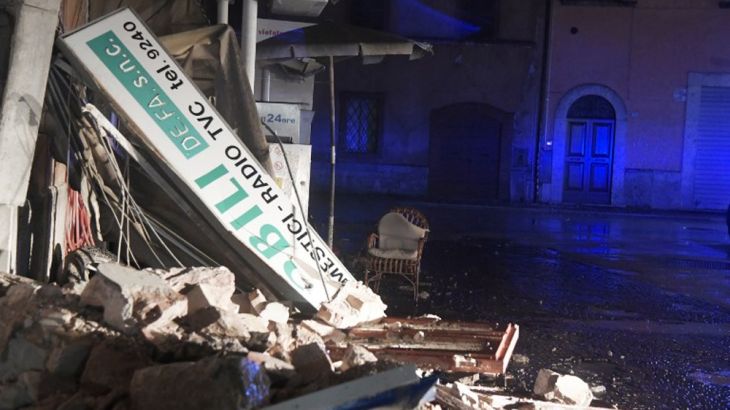Central Italy rocked by two earthquakes
No deaths reported after twin earthquakes cause severe damage in the area that was hit two months ago.

A series of strong earthquakes rocked a wide area of central Italy, striking fear among residents rattled by a deadly tremor in August, but there were no reports of casualties and few serious injuries.
The earthquakes toppled buildings and injured dozens, according to initial reports, hitting the same region that saw nearly 300 people killed in August this year.
Keep reading
list of 4 itemsHow is Afghanistan coping six months after deadly quakes?
‘Violent rumble’: 4.8 magnitude earthquake rattles New York City, northeast
Taiwan searches for 18 still missing after Wednesday’s earthquake
The first 5.5-magnitude quake sent people running out of their houses on Wednesday, before the second, a more destructive 6.1-magnitude one, struck two hours later.
Rescuers working through the night and in the rain were struggling to assess the full extent of the disaster.
About five hours after the first quake, Civil Protection department chief Fabrizio Curcio said “tens” of people were reported hurt but only four suffered serious, non-life threatening injuries.
|
|
“The reports are not as catastrophic as we feared,” he said.
The quakes were felt in the capital, Rome, sending residents running out of their houses and into the streets.
The second was felt as far away as Venice in the far north, and Naples, south of the capital.
“Many houses have collapsed. Our town is finished,” Marco Rinaldi, mayor of the mountain town of Ussita, told Sky Italy television by telephone.
“The second quake was a long, terrible one,” he said.
![Temporary accommodation was offered to residents who were unable to return to their homes after the earthquakes [Tiziana Fabi/AFP]](/wp-content/uploads/2016/10/329184a553e849eeb90e2f44705af777_18.jpeg)
The US Geological Survey (USGS) registered a first 5.5-magnitude quake at 19:10 local time (17:10 GMT).
The mayor of Serravalle del Chienti, Gabriele Santamarianova, said the quake felt “like bombs were falling”.
“We saw a cloud of dust. We don’t yet know what has fallen down. We’ll see once the sun comes up.”
Castel Sant’Angelo mayor Mauro Falcucci told Sky: “There is no electricity. There are bound to be house collapses. On top of this there are torrential rains.”
In August, a 6.0-6.2 magnitude quake flattened the mountain town of Amatrice – 70km from Visso – killing 297 people and injuring hundreds of others.
The area is also not far from L’Aquila, where a powerful earthquake killed more than 300 in 2009.
#terremoto dal web i crolli pic.twitter.com/4YLJ8AgHxs
— Angelo Maggioni (@AngeloMaggioni3) October 26, 2016
After the second quake, Italian television channels broadcast images of collapsed buildings and people standing dazed in front of their toppled houses.
“It is not very easy to make assessments in the dark and the weather is bad in the whole region. We will have to see more precisely in the light of day,” said Curcio.
Amateur video footage on television showed clouds of dust rising as parts of buildings collapsed in some towns, including Camerino in the Marche region, where a bell tower fell on a building.
Massive boulders, some the size of cars, fell on the main north-south road of the Nera River valley that links mountain communities.
The historic late 15th-century rural church of San Salvatore in Campo, near Norcia in the Umbria region, which had been weakened by the August quake, collapsed.
For people unable to return home immediately, civil protection arranged accommodation in gyms and prepared to reopen some of the tent camps which were set up after the August earthquake.
Many residents prepared to spend the night in their cars.
![The village of Borgo Sant'Antonio near Visso was also badly affected by the twin earthquakes [Tiziana Fabi/AFP] Italian television channels broadcast images of collapsed buildings and people standing dazed in front of their toppled houses [Tiziana Fabi/AFP]
Rescuers working through the night and in the rain were struggling to assess the full extent of the disaster [Reuters]](/wp-content/uploads/2016/10/1d96e270cd0a408a9c0c3cb9038165c8_18.jpeg)
Rescuers working through the night and in the rain were struggling to assess the full extent of the disaster [Reuters]